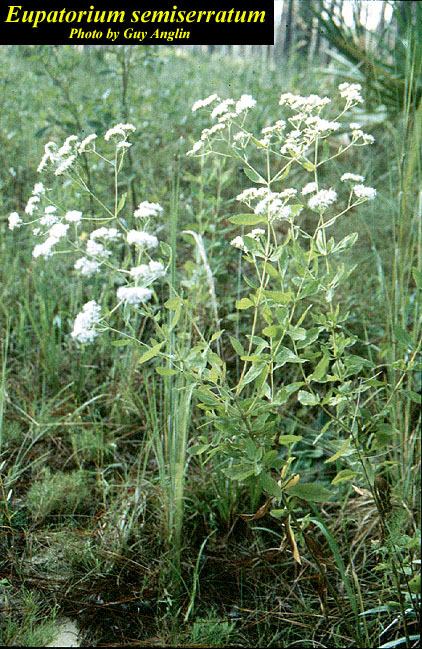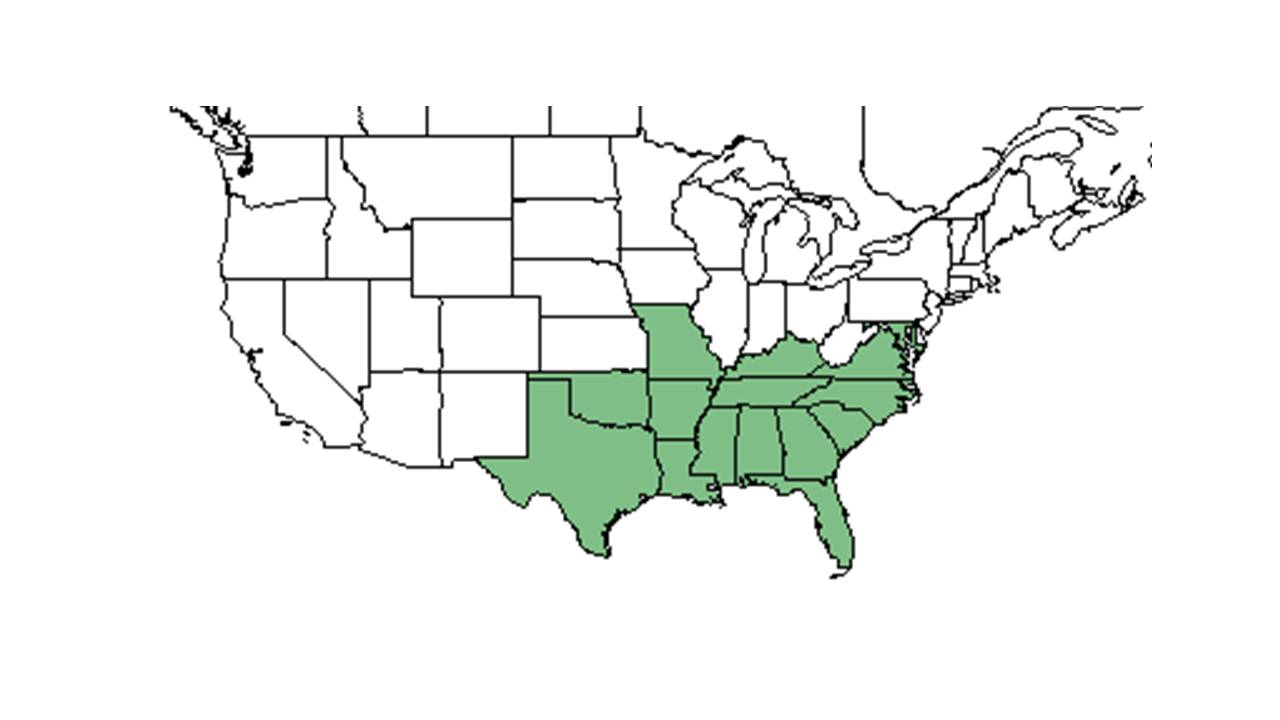Difference between revisions of "Eupatorium semiserratum"
KatieMccoy (talk | contribs) (→References and notes) |
KatieMccoy (talk | contribs) |
||
| Line 30: | Line 30: | ||
It has well-documented anticancer activities against various human cancer cell lines.<ref>Kintzios, S. E. (2007). "Terrestrial plant-derived anticancer agents and plant species used in anticancer research." Critical Reviews in Plant Sciences 25: 79-113.</ref> | It has well-documented anticancer activities against various human cancer cell lines.<ref>Kintzios, S. E. (2007). "Terrestrial plant-derived anticancer agents and plant species used in anticancer research." Critical Reviews in Plant Sciences 25: 79-113.</ref> | ||
===Habitat=== <!--Natural communities, human disturbed habitats, topography, hydrology, soils, light, fire regime requirements for removal of competition, etc.--> | ===Habitat=== <!--Natural communities, human disturbed habitats, topography, hydrology, soils, light, fire regime requirements for removal of competition, etc.--> | ||
| − | + | ''E. semiserratum'' occurs in live oak hammocks, between floodplain swamps and powerline corridors, in depressions in flatwoods, longleaf pine-wiregrass savannas, pine flatwoods, scrub oak, banks of rivers, edges of cypress depressions, and in wet drainages on open wooded slopes. It is also found in human disturbed habitats such as roadside ditches and depressions, powerline corridors, and in areas that have been clear cut and plowed<ref name=fsu>Florida State University Robert K. Godfrey Herbarium database. URL: http://herbarium.bio.fsu.edu. Last accessed: June 2014. Collectors: Robert K. Godfrey, Richard D. Houk, Loran C. Anderson, Victoria I. Sullivan, Kurt E. Blum, R. L. Lazor, R. Kral, Gary R. Knight, J. P. Gillespie, John Lazor, Paul L. Redfearn, Jr., S. C. Hood, R. A. Norris, R. F. Doren, and Annie Schmidt. States and Counties: Florida: Calhoun, Escambia, Franklin, Gadsden, Gulf, Holmes, Jackson, Jefferson, Lafayette, Leon, Liberty, Nassau, Okaloosa, Santa Rosa, Walton, and Washington. Georgia: Atkinson, Baker, and Thomas.</ref>. | |
Associated species include ''Pinus taeda, P. palutris, P. elliottii, Serenoa repens, Taxodium distichum, Liquidambar styraciflua, Eupatorium pilosum, E. semiserratum, E. recurvans, E. leucolepis, E. cuneifolium, E. mohrii, E. scabridum''<ref name=fsu/>. | Associated species include ''Pinus taeda, P. palutris, P. elliottii, Serenoa repens, Taxodium distichum, Liquidambar styraciflua, Eupatorium pilosum, E. semiserratum, E. recurvans, E. leucolepis, E. cuneifolium, E. mohrii, E. scabridum''<ref name=fsu/>. | ||
Revision as of 13:27, 3 May 2016
| Eupatorium semiserratum | |
|---|---|

| |
| Photo by Guy Anglin, Atlas of Florida Vascular Plants | |
| Scientific classification | |
| Kingdom: | Plantae |
| Division: | Magnoliophyta - Flowering plants |
| Class: | Magnoliopsida – Dicotyledons |
| Order: | Asterales |
| Family: | Asteraceae ⁄ Compositae |
| Genus: | Eupatorium |
| Species: | E. semiserratum |
| Binomial name | |
| Eupatorium semiserratum DC. | |

| |
| Natural range of Eupatorium semiserratum from USDA NRCS Plants Database. | |
Common name: smallflower thoroughwort
Contents
Taxonomic notes
Synonym: Eupatorium cuneifolium var. semiserratum (A.P. de Candolle) Fernald & Griscom
Description
A description of Eupatorium semiserratum is provided in The Flora of North America.
Distribution
Ecology
It has well-documented anticancer activities against various human cancer cell lines.[1]
Habitat
E. semiserratum occurs in live oak hammocks, between floodplain swamps and powerline corridors, in depressions in flatwoods, longleaf pine-wiregrass savannas, pine flatwoods, scrub oak, banks of rivers, edges of cypress depressions, and in wet drainages on open wooded slopes. It is also found in human disturbed habitats such as roadside ditches and depressions, powerline corridors, and in areas that have been clear cut and plowed[2].
Associated species include Pinus taeda, P. palutris, P. elliottii, Serenoa repens, Taxodium distichum, Liquidambar styraciflua, Eupatorium pilosum, E. semiserratum, E. recurvans, E. leucolepis, E. cuneifolium, E. mohrii, E. scabridum[2].
Phenology
It has been observed flowering from August to October[2].
Conservation and Management
Cultivation and restoration
Photo Gallery
References and notes
- ↑ Kintzios, S. E. (2007). "Terrestrial plant-derived anticancer agents and plant species used in anticancer research." Critical Reviews in Plant Sciences 25: 79-113.
- ↑ 2.0 2.1 2.2 Florida State University Robert K. Godfrey Herbarium database. URL: http://herbarium.bio.fsu.edu. Last accessed: June 2014. Collectors: Robert K. Godfrey, Richard D. Houk, Loran C. Anderson, Victoria I. Sullivan, Kurt E. Blum, R. L. Lazor, R. Kral, Gary R. Knight, J. P. Gillespie, John Lazor, Paul L. Redfearn, Jr., S. C. Hood, R. A. Norris, R. F. Doren, and Annie Schmidt. States and Counties: Florida: Calhoun, Escambia, Franklin, Gadsden, Gulf, Holmes, Jackson, Jefferson, Lafayette, Leon, Liberty, Nassau, Okaloosa, Santa Rosa, Walton, and Washington. Georgia: Atkinson, Baker, and Thomas.